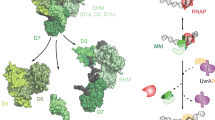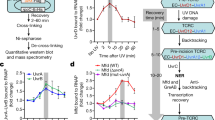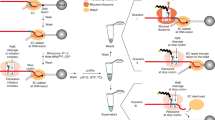Abstract
Transcription-coupled DNA repair uses components of the transcription machinery to identify DNA lesions and initiate their repair. These repair pathways are complex, so their mechanistic features remain poorly understood. Bacterial transcription-coupled repair is initiated when RNA polymerase stalled at a DNA lesion is removed by Mfd, an ATP-dependent DNA translocase1,2,3. Here we use single-molecule DNA nanomanipulation to observe the dynamic interactions of Escherichia coli Mfd with RNA polymerase elongation complexes stalled by a cyclopyrimidine dimer or by nucleotide starvation. We show that Mfd acts by catalysing two irreversible, ATP-dependent transitions with different structural, kinetic and mechanistic features. Mfd remains bound to the DNA in a long-lived complex that could act as a marker for sites of DNA damage, directing assembly of subsequent DNA repair factors. These results provide a framework for considering the kinetics of transcription-coupled repair in vivo, and open the way to reconstruction of complete DNA repair pathways at single-molecule resolution.
This is a preview of subscription content, access via your institution
Access options
Subscribe to this journal
Receive 51 print issues and online access
$199.00 per year
only $3.90 per issue
Buy this article
- Purchase on Springer Link
- Instant access to full article PDF
Prices may be subject to local taxes which are calculated during checkout




Similar content being viewed by others
References
Selby, C. P. & Sancar, A. Molecular mechanism of transcription-repair coupling. Science 260, 53–58 (1993)
Witkin, E. M. Time, temperature, and protein synthesis: a study of ultraviolet-induced mutation in bacteria. Cold Spring Harb. Symp. Quant. Biol. 21, 123–140 (1956)
Mellon, I. & Hanawalt, P. C. Induction of the Escherichia coli lactose operon selectively increases repair of its transcribed DNA strand. Nature 342, 95–98 (1989)
Hanawalt, P. C. & Spivak, G. Transcription-coupled DNA repair: two decades of progress and surprises. Nature Rev. Mol. Cell Biol. 9, 958–970 (2008)
Selby, C. P. & Sancar, A. Gene- and strand-specific repair in vitro: partial purification of a transcription-repair coupling factor. Proc. Natl Acad. Sci. USA 88, 8232–8236 (1991)
Selby, C. P. & Sancar, A. Transcription-repair coupling and mutation frequency decline. J. Bacteriol. 175, 7509–7514 (1993)
Park, J. S., Marr, M. T. & Roberts, J. W. E. coli transcription repair coupling factor (Mfd protein) rescues arrested complexes by promoting forward translocation. Cell 109, 757–767 (2002)
Smith, A. J., Szczelkun, M. D. & Savery, N. J. Controlling the motor activity of a transcription-repair coupling factor: autoinhibition and the role of RNA polymerase. Nucleic Acids Res. 35, 1802–1811 (2007)
Smith, A. J. & Savery, N. J. Effects of the bacterial transcription-repair coupling factor during transcription of DNA containing non-bulky lesions. DNA Repair (Amst.) 7, 1670–1679 (2008)
Chambers, A. L., Smith, A. J. & Savery, N. J. A DNA translocation motif in the bacterial transcription–repair coupling factor, Mfd. Nucleic Acids Res. 31, 6409–6418 (2003)
Deaconescu, A. M. et al. Structural basis for bacterial transcription-coupled DNA repair. Cell 124, 507–520 (2006)
Deaconescu, A. M. & Darst, S. A. Crystallization and preliminary structure determination of Escherichia coli Mfd, the transcription-repair coupling factor. Acta Crystallogr. F 61, 1062–1064 (2005)
Westblade, L. F. et al. Structural basis for the bacterial transcription-repair coupling factor/RNA polymerase interaction. Nucleic Acids Res. 38, 8357–8369 (2010)
Deaconescu, A. M., Savery, N. J. & Darst, S. A. The bacterial transcription repair coupling factor. Curr. Opin. Struct. Biol. 17, 96–102 (2007)
Park, J. S. & Roberts, J. W. Role of DNA bubble rewinding in enzymatic transcription termination. Proc. Natl Acad. Sci. USA 103, 4870–4875 (2006)
Savery, N. J. The molecular mechanism of transcription-coupled DNA repair. Trends Microbiol. 15, 326–333 (2007)
Revyakin, A., Liu, C. Y., Ebright, R. H. & Strick, T. R. Abortive initiation and productive initiation by RNA polymerase involve DNA scrunching. Science 314, 1139–1143 (2006)
Revyakin, A., Ebright, R. H. & Strick, T. R. Promoter unwinding and promoter clearance by RNA polymerase: detection by single-molecule DNA nanomanipulation. Proc. Natl Acad. Sci. USA 101, 4776–4780 (2004)
Revyakin, A. et al. Single-molecule DNA nanomanipulation: detection of promoter-unwinding events by RNA polymerase. Methods Enzymol. 370, 577–598 (2003)
Smith, A. J. & Savery, N. J. RNA polymerase mutants defective in the initiation of transcription-coupled DNA repair. Nucleic Acids Res. 33, 755–764 (2005)
Kou, S. C. et al. Single-molecule Michaelis–Menten equations. J. Phys. Chem. B 109, 19068–19081 (2005)
Brueckner, F., Hennecke, U., Carell, T. & Cramer, P. CPD damage recognition by transcribing RNA polymerase II. Science 315, 859–862 (2007)
Komissarova, N. et al. Shortening of RNA:DNA hybrid in the elongation complex of RNA polymerase is a prerequisite for transcription termination. Mol. Cell 10, 1151–1162 (2002)
Srivastava, D. B. & Darst, S. A. Derepression of bacterial transcription-repair coupling factor is associated with a profound conformational change. J. Mol. Biol. 406, 275–284 (2011)
Landick, R. The regulatory roles and mechanism of transcriptional pausing. Biochem. Soc. Trans. 34, 1062–1066 (2006)
Manelyte, L. et al. Regulation and rate enhancement during transcription-coupled DNA repair. Mol. Cell 40, 714–724 (2010)
Selby, C. P. & Sancar, A. Structure and function of transcription-repair coupling factor. I. Structural domains and binding properties. J. Biol. Chem. 270, 4882–4889 (1995)
Deaconescu, A. M., Sevostyanova, A., Artsimovitch, I. & Grigorieff, N. Nucleotide excision repair (NER) machinery recruitment by the transcription-repair coupling factor involves unmasking of a conserved intramolecular interface. Proc. Natl Acad. Sci. USA 109, 3353–3358 (2012)
Acknowledgements
We thank K. Neumann for showing us how to perform global fitting with the Igor software package. K.H. was supported by a PhD scholarship from the Frontieres Interdisciplinaires du Vivant Doctoral Program and the Fondation pour la Recherche Médicale. Work in the laboratory of N.J.S. was supported by BBSRC grant BB/I003142/1, and work in the laboratory of S.A.D. was supported by National Institutes of Health grant GM073829. This work was also made possible by a EURYI grant, in addition to CNRS and University of Paris Diderot core funding, to T.R.S.
Author information
Authors and Affiliations
Contributions
K.H., N.J.S. and T.R.S. devised and carried out experiments; S.A.D., K.H., N.J., N.J.S., A.J.S., T.R.S. and L.F.W. provided unique reagents and A.J.S. carried out further control experiments; K.H., W.G., N.J.S., T.R.S. and S.Z. analysed data; and S.A.D., N.J.S. and T.R.S. wrote the paper.
Corresponding author
Ethics declarations
Competing interests
The authors declare no competing financial interests.
Supplementary information
Supplementary Information
This file contains the Supplementary Materials and Methods, Supplementary References, Supplementary Figures 1-12 and the Supplementary Table. (PDF 2633 kb)
Rights and permissions
About this article
Cite this article
Howan, K., Smith, A., Westblade, L. et al. Initiation of transcription-coupled repair characterized at single-molecule resolution. Nature 490, 431–434 (2012). https://doi.org/10.1038/nature11430
Received:
Accepted:
Published:
Issue Date:
DOI: https://doi.org/10.1038/nature11430
This article is cited by
-
Polarity of the CRISPR roadblock to transcription
Nature Structural & Molecular Biology (2022)
-
Single-molecule imaging reveals molecular coupling between transcription and DNA repair machinery in live cells
Nature Communications (2020)
-
Single-molecule live-cell imaging visualizes parallel pathways of prokaryotic nucleotide excision repair
Nature Communications (2020)
-
Single-molecule characterization of extrinsic transcription termination by Sen1 helicase
Nature Communications (2019)
-
The transcription-repair coupling factor Mfd associates with RNA polymerase in the absence of exogenous damage
Nature Communications (2018)
Comments
By submitting a comment you agree to abide by our Terms and Community Guidelines. If you find something abusive or that does not comply with our terms or guidelines please flag it as inappropriate.



